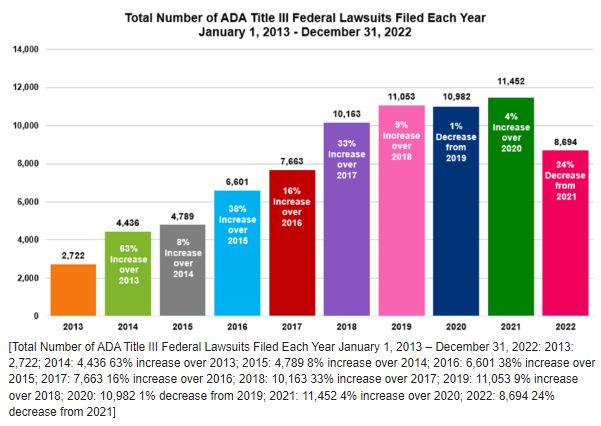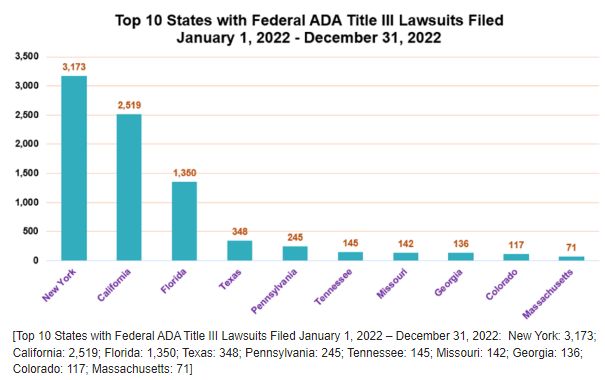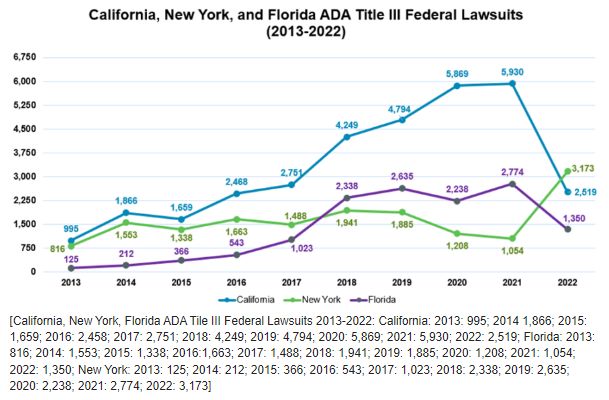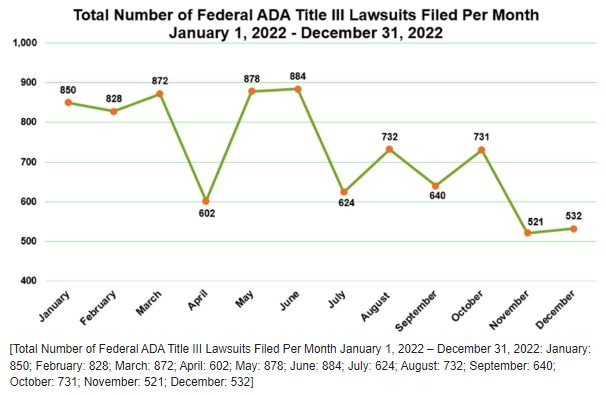eyfarth Synopsis: The number of ADA Title III lawsuits filed in federal court dropped by 24 percent, the lowest since 2017, and California is no longer the epicenter.
ADA Title III case filings in federal court had been on a sharp upward trajectory since we started compiling these statistics in 2013. That year, there were only 2,722 lawsuits nationwide. Eight years later, in 2021, there were 11,452 such lawsuits. In-between, year over year increases ranged from 4% to 63%. 2020 was the only “down” year, with a 1% slight decrease which was likely attributable to pandemic restrictions.
We now have a second, far more significant, “down” year. In 2022, Plaintiffs filed 8,694 Title III lawsuits in federal courts, a drop of 2,758 cases, or 24.1%, from 2021. However, compared to the 2,722 total lawsuit count in 2013, 8,694 lawsuits is still a very significant number of lawsuit filings for a fairly discrete area of the law, and marks an astounding 319% increase from 2013.

The other big news is that California – the historical leader in ADA Title III litigation – has fallen behind New York. Plaintiffs filed 3,173 cases in the Empire State compared with 2,519 in the Golden State. Third on the list was Florida with 1,350. Rounding out the top five (well behind the leaders) were Texas with 348 and Pennsylvania with 245 lawsuits. Sixth through tenth places went to: Tennessee (145), Missouri (142), Georgia (136), Colorado (117) and Massachusetts (71). (Missouri is a newcomer to the top ten.) Nevada and Illinois dropped out of the top 10. Illinois came in at number 11 with 63 cases and Nevada plummeted to 4 cases from 130 in 2021.


The states with no federal ADA Title III filings in 2022 were Alaska, Iowa, North Dakota, South Dakota and Vermont.
The end of the year was the least busy time for filings – November and December had 521 and 532 filings respectively. The busiest months? June (884), May (878) and March (872). The year started out busy, but dropped precipitously in the second half.

So what’s behind this decrease in filings? As we discussed in a post about the mid-year lawsuit numbers, one prolific plaintiff’s firm in Southern California was sued by the Los Angeles and San Francisco District Attorneys which may have slowed down their filings. That lawsuit was dismissed by the trial court (an appeal has been taken) so that firm may return to its normal pace of filings in 2023. Several attorneys from that firm also left to form their own firm which will likely result in additional filings in California. Furthermore, the Ninth Circuit Court of Appeals issued a decision in October 2022 that was unfavorable to plaintiffs’ attorneys which might have had a chilling effect for the rest of the year. Unfortunately for businesses, a different panel of the Ninth Circuit reversed course in January 2023 when it issued a decision which will likely cause a surge in new filings by serial plaintiff “testers” unless it is rescinded. The defendant in that case has filed a Petition for Rehearing En Banc which is under consideration.
We should note that federal website accessibility lawsuits accounted for 37% of the 8,694 ADA Title III lawsuits filed in federal court in 2022 – the largest percentage ever. This is not surprising because serial plaintiffs can visit websites for the purpose of filing a lawsuit without even leaving their house. Lawsuits involving physical barriers typically require a visit to the place of business.
A note on our methodology: Our research involved a painstaking manual process of going through all federal cases that were coded as “ADA-Other,” manually culling out the ADA Title II cases in which the defendants are state and local governments, and categorizing them by state. The manual process means there is the small possibility of human error.

